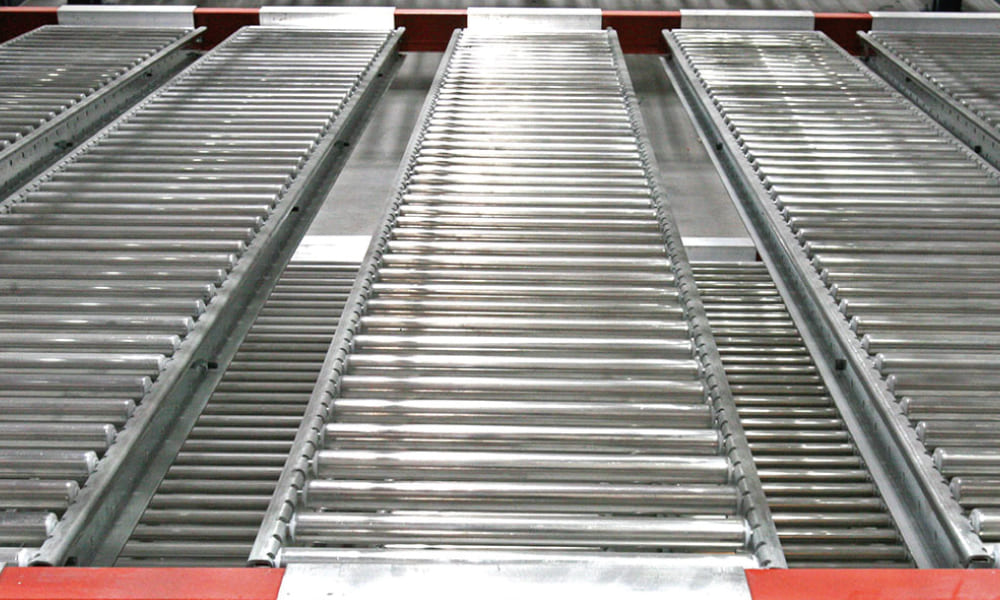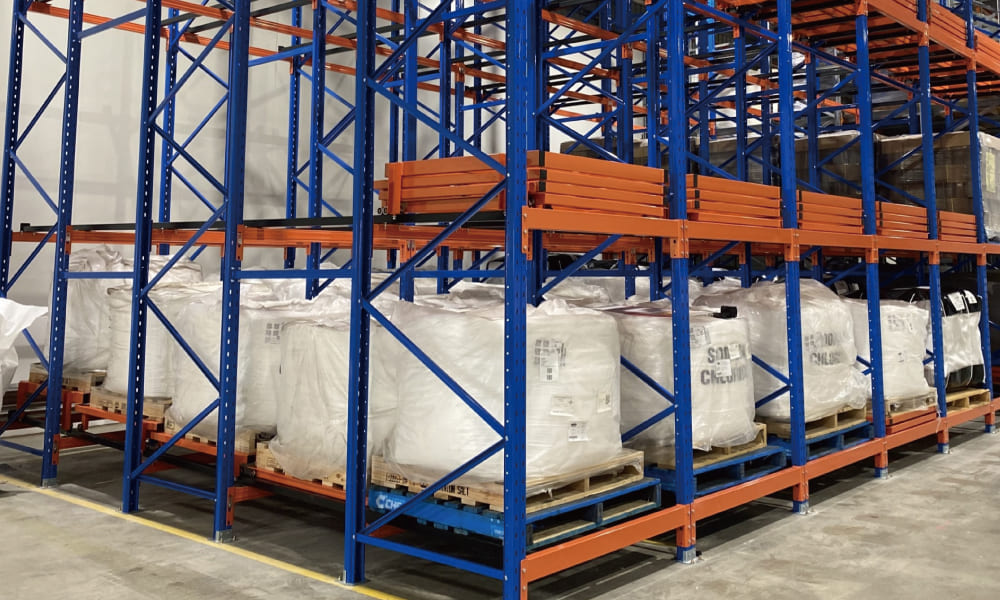Introduction
Pallet Live Storage, a high-density storage solution, not surprising, offers an effective way to optimize warehouse capacity while maintaining
the stock flow rate. But what exactly is pallet live storage, and how can it transform your warehouse operations?
In this comprehensive guide, we’ll explore the ins and outs of pallet live storage, its benefits, types, and strategies to help you understand why this system is rapidly becoming a game-changer in the logistics world.

What Is Pallet Live Storage?
Pallet Live Storage refers to a dynamic storage system designed to handle the movement of heavy-duty items by enabling pallets to flow smoothly along a slightly inclined bed of rollers.
This system allows goods to move from the loading end to the unloading end through the force of gravity, minimizing the need for manual handling. It’s an ideal solution for high-density environments where space-saving and stock turnover control are key priorities.
The pallet live storage system is particularly useful for businesses looking to optimize stock management with fast-moving products. By automating the flow of products, pallet live storage reduces time spent on handling and retrieval, streamlining the entire warehouse operation.
Main Types of Pallet Live Storage Systems
There are two primary types of pallet live storage systems:
- Gravity Fed Pallet Live Storage (FIFO): This system is perfect for warehouses where maintaining stock turnover is vital. It has separate loading and retrieval points, ensuring that the first pallet in is always the first one out. The gentle incline of the roller beds allows gravity to move the pallet to the unloading side automatically. It’s an efficient solution for fast-moving goods that need regular restocking.
- Push Back Pallet Live Storage (LIFO): In contrast, push-back systems are designed for LIFO operations. Pallets are loaded and unloaded from the same side. As one pallet is retrieved, the next pallet in line is automatically pushed forward, making this system ideal for storing a high number of SKUs in less space.

How Does Pallet Live Storage Work?
Pallet live storage systems are built with a slightly inclined roller bed that allows pallets to glide from the loading area to the retrieval point through gravity. The system can be set up for either FIFO (First In, First Out) or LIFO (Last In, First Out) operations.
In FIFO systems, the first pallet loaded is the first one to be retrieved. This is ideal for perishable goods or products with expiration dates, where stock turnover control is crucial. In LIFO systems, the last pallet loaded is the first one retrieved, making it better suited for items with longer shelf life or less frequent stock rotation.
Key Benefits of Pallet Live Storage
- Space Optimization: Pallet live storage systems make use of vertical space and compact structures, enabling businesses to store more inventory in less floor space.
- Improved Stock Rotation: Depending on your needs, pallet live storage supports both FIFO (First In, First Out) and LIFO (Last In, First Out) methodologies for stock control.
- Enhanced Productivity: Automated flow reduces the manual labor involved in inventory management, making your operation faster and more efficient.
- Reduced Retrieval Time: Gravity-fed roller beds move pallets efficiently from the loading point to the retrieval point, saving time in warehouse processes.
Practical Tips for Implementing Pallet Live Storage
When considering the switch to pallet live storage, keep these strategies in mind to maximize the system's potential:
1. Analyze Your Stock Rotation Needs: Determine whether a FIFO or LIFO setup best suits your products. For perishable goods or items with a short shelf life, FIFO systems are crucial, whereas LIFO works well for items that don’t require frequent stock turnover.
2. Optimize Aisle Width: Ensure that the layout of your warehouse supports the smooth flow of pallets. Reducing aisle width in favor of vertical storage can help you make the most of your space.
3. Leverage Automation: While pallet live storage uses gravity for the actual movement of pallets, you can integrate autonomous mobile solutions like robotic forklifts or shuttle systems to further streamline the loading and retrieval process.
4. Evaluate Load Capacities: Ensure your pallet live storage racks are capable of supporting the weight and size of your pallets. The roller beds should be equipped to handle the specific loads that pass through your warehouse.
Implementing Gravity-Fed Pallet Live Storage (FIFO)

Gravity-fed pallet live storage is an ideal solution for companies that need first-in, First Out (FIFO) stock rotation. This system is particularly beneficial for industries that handle perishable goods, pharmaceuticals, or items with expiration dates, where stock turnover control is essential.
Key Steps for Implementation:
- Rack Design and Layout: Gravity-fed systems require racking with a slightly inclined roller track, allowing pallets to move automatically from the loading side to the unloading side. The racks should be designed to separate the loading and retrieval points, ensuring seamless product flow. Each lane of the rack should be dedicated to a specific SKU for efficient stock control.
- Space Allocation: Since FIFO systems ensure that the first pallet loaded is the first one retrieved, these racks are often designed with separate loading and retrieval aisles. Proper aisle width should be allocated to allow forklifts to load and unload efficiently.
- Inventory Management: Implement clear labeling and tracking systems to ensure that products are loaded in the correct order and that stock is rotated properly. This prevents bottlenecks and ensures that the system runs smoothly.
- Integration with Warehouse Management Systems (WMS): To enhance efficiency, integrate the gravity-fed system with your WMS. This will automate inventory tracking, ensuring that the oldest stock is picked first, and maintaining the integrity of the FIFO process.
Industries That Benefit:
- Food and Beverage: Ensure perishable goods are rotated and sold before expiration.
- Pharmaceuticals: Ideal for maintaining compliance with expiration-sensitive products.
Implementing Push-Back Pallet Live Storage (LIFO)

Push-back pallet live storage is designed for Last In, First Out (LIFO) operations, making it suitable for businesses with non-perishable goods or operations where the number of SKUs prevails over the volume of each SKU. This system allows for greater flexibility in loading and retrieval, as both processes occur from the same side of the rack.
Key Steps for Implementation:
- Rack Configuration: The push-back system involves racking where pallets are loaded onto a series of nested carts that move back when a new pallet is loaded. When one pallet is retrieved, the next one in line is pushed forward. Configure the racks to accommodate the depth and weight of the pallets, as each lane will typically store multiple pallets deep.
- Space Utilization: Since the loading and unloading occur on the same side, push-back racking systems require fewer aisles than FIFO systems. This can significantly increase space efficiency in warehouses with a higher SKU count or where space is a critical factor.
- Handling SKUs: Because each lane can store multiple pallets of the same SKU, ensure that similar or related products are grouped for ease of retrieval. Labeling each lane correctly is essential to avoid confusion during retrieval.
- Training for Warehouse Staff: Ensure that your warehouse team understands how to load and unload pallets correctly to maintain the integrity of the LIFO system. Since the system involves carts that move back and forth, careful operation is needed to avoid accidents or product damage.
Industries That Benefit:
- Manufacturing and Automotive: Ideal for storing durable goods that do not require frequent rotation.
- Retail Warehousing: Efficient for handling seasonal or less frequently rotated items.
Combination of FIFO and LIFO Systems
In some cases, warehouses may require a hybrid solution where both FIFO and LIFO systems are implemented together to meet varying inventory needs. For example, a warehouse could use gravity-fed pallet live storage for perishable items on one side, while employing push-back racking for non-perishable or slower-moving goods.
Key Steps for Implementation:
- Zoning: Divide your warehouse into zones where each type of racking system is most appropriate. This allows you to handle both perishable and non-perishable goods efficiently.
- Customized Aisle Layouts: Ensure that aisle configurations support both the FIFO and LIFO systems. You may need wider aisles for FIFO areas, while LIFO systems can work in narrower spaces due to the single-sided access.
- Technology Integration: Use warehouse management software to coordinate the movement of goods across the different zones, ensuring that inventory levels are optimized and that each SKU is stored in the most appropriate type of rack.
Conclusion
Looking to take your warehouse to the next level? Explore pallet live storage today and experience the benefits of increased inventory control, optimized space utilization, and enhanced efficiency.
FAQs
1. What Industries Benefit Most from Pallet Live Storage?
Industries with high-volume storage needs, such as food and beverage, pharmaceuticals, retail, and manufacturing, find pallet live storage particularly beneficial. Companies dealing with perishable goods can ensure efficient stock rotation, while businesses with high SKU counts can manage large inventories without taking up excessive space.
2. How Does Pallet Live Storage Compare to Other Storage Solutions?
Compared to other storage systems like ASRS (Automated Storage and Retrieval Systems) or traditional pallet racking, pallet live storage offers a more straightforward and cost-effective solution for dynamic stock management. It requires less energy and investment compared to fully automated storage systems while still providing significant benefits in space-saving and operational efficiency.





 español
español English
English français
français русский
русский Tiếng việt
Tiếng việt العربية
العربية
 Obtenga una cuota gratis
Obtenga una cuota gratis





 RED SOPORTADA
RED SOPORTADA
